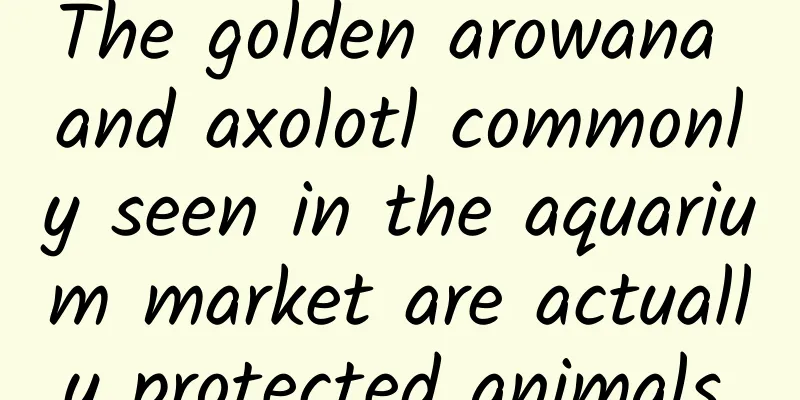The golden arowana and axolotl commonly seen in the aquarium market are actually protected animals.

|
The beautiful bony tongue fish in the picture has a well-known common name - Golden Arowana. It has been artificially improved and has a gorgeous appearance, resembling the legendary dragon, so many people regard it as a Feng Shui fish and a fish that attracts wealth. In the aquarium market, Golden Arowana is very popular, and good-looking ones can cost tens of millions. Scleropages formosus | Karelj / Wikimedia Commons However, overfishing has put the wild beautiful hard bone tongue fish into an endangered situation. In the Convention on International Trade in Endangered Species of Wild Fauna and Flora (CITES), it is listed in Appendix I - which means that unless there is a special necessity, international trade in beautiful hard bone tongue fish is prohibited. my country has also approved its wild population as a national key second-level protected animal based on the CITES Appendix. So, can this fish still be bought and kept? What about other animals commonly seen in the aquarium market? How do you know if these fish can be kept? In recent years, with the increasing emphasis on environmental protection, many aquatic species traditionally raised in ornamental pens have been included in the protection list. To know which fish can be bought and sold and which fish require a license to raise, we must first determine their position in the animal list of our country. At present, in my country, the main basis for judging the level of animal protection is the "National Key Protected Wildlife List"; at the same time, the Fisheries Administration of the Ministry of Agriculture and Rural Affairs has formulated a list of aquatic species protection based on the CITES Appendix (full name: "List of Aquatic Animal Species Approved as National Key Protected Wildlife in the Appendix of the Convention on International Trade in Endangered Species of Wild Fauna and Flora (CITES)"). In addition, there is also the national "Three Have Animals List" (full name: "Nationally Protected List of Terrestrial Wildlife with Important Economic and Scientific Research Value") and the list of protected animals promulgated by various places in their jurisdictions. The "National Key Protected Wild Animals List" was formulated based on the current status of my country's wildlife resources and focuses on my country's native species; the "National Key Protected Wild Animals List" was formulated based on the international protection levels and grades of various important wild animals and is a reference list further combined with my country's current situation. Red dragonfish is also a beautiful bony tongue fish|Marcel Burkhard / Wikimedia Commons For example, the beautiful arowana mentioned above does not appear in my country's wild protected list, but appears in the protection list approved by the CITES Appendix. my country has approved it as a first-class protected animal in accordance with CITES, and the protected object is stipulated as the wild population. In other words, the golden arowana from the wild is a protected wild animal, while the artificially bred one is not a protected wild animal. After the golden arowana was developed as an ornamental fish, it was derived into varieties such as the crossback golden arowana and the red arowana, all of which belong to the golden arowana. In addition, its close relative, the beautiful bony tongue fish (only wild populations), is also approved as a protected animal (secondary). Fortunately, the golden arowana raised or sold today are basically artificial populations, and we usually don’t buy golden arowana from the wild. Scleropages inscriptus is also known as the Totem Dragonfish | Kamphol Udomritthiruj / seriouslyfish.com In addition to the golden arowana, what other common aquarium creatures are on the list? What kind of control do they need to be subject to? These fish only protect wild populations White Cloud Gold Silk The Baiyun Golden Threadfish is also known as the "Tang Fish". This omnivorous small fish native to mountain streams in southern my country is not only brightly colored and patterned, but also resistant to low temperatures, hardy and easy to raise, and inexpensive, making it an entry-level ornamental fish for countless aquarium enthusiasts. The Baiyun Golden Threadfish has a black and silver band running through its body, which is matched with the red and yellow patches on its tail and pelvic fins, making it very beautiful. After years of artificial breeding efforts, the Baiyun Golden Threadfish now has albino and long-fin varieties, also known as "yellow Baiyun Golden Threadfish" and "big sail Baiyun Golden Threadfish". Tanichthys albonubes | sannse / Wikimedia Commons However, due to habitat loss and other issues, the wild population of this cheap small fish has dropped sharply. Currently, the wild white cloud golden silk is listed as a critically endangered species in my country's Red List of Biodiversity, and its wild population is also listed as a second-class protected animal in the "National Key Protected Wildlife List". Red snapper The freshwater mullet, also known as "smooth sailing", was once a very common edible fish in the Yangtze River system of my country. Adult mullets have a towering dorsal fin and sexy thick lips. Juvenile mullets have black and white stripes all over their bodies, which turn into color bands running through their bodies when they grow up - the female adult mullets have unclear black bands, while the male's color bands turn into crimson and run through the fish's head, making it as beautiful as if it were painted with rouge, hence the name. Myxocyprinus asiaticus | Chinese Academy of Fishery Sciences The lifespan of Chinese mullet is long, and the adult can grow to nearly 1 meter. Most of the fish raised in the ornamental fish industry are fry. Juvenile Chinese mullet is cute, with distinct colors, and is a cold-water fish that does not require heating, which is favored by many native fish lovers. In recent years, thanks to the breakthrough and continuous expansion of artificial breeding, more and more artificial second-generation Chinese mullet have entered the ornamental fish market at a more affordable price, and are also heading towards the edible fish market. However, in recent years, due to environmental damage in the Yangtze River Basin and overfishing, the number of Chinese mullet in the wild has sharply decreased. In the "National Key Protected Wildlife List", the wild population of Chinese mullet is listed as a Class II protected animal. These fish, both captive and wild populations, are protected Arapaima Arapaima, also known as the "elephant fish", has existed on Earth for more than 100 million years. Adult Arapaima can be over 2.5 meters in size, and historical records show that it can be over 4 meters long. Even piranhas dare not provoke it easily. Arapaima has super strong scales and huge brute force. It has a strong impact force and can even easily break human bones. Arapaima gigas | Citron / Wikimedia Commons Arapaima is a domineering adult, and it is often impossible to keep it in an ordinary aquarium, but its fry are the favorites of many aquarium enthusiasts. Even as a fry, Arapaima has a domineering swimming posture and eats shockingly; as it grows, red spots will gradually appear on the back half of the body, and the whole body will present a light olive green metallic luster. However, the Arapaima is a species listed in Appendix II of CITES, and my country has also approved it as a Class II protected animal in accordance with CITES, without distinguishing between wild and artificial populations. Therefore, those who artificially breed and sell Arapaima will be treated as breeding and commercial use of national protected animals. Thick-lipped loach The thick-lipped loach, native to the mountain streams of Dayao Mountain in Guangxi Province, my country, has black and white stripes in its larvae, similar to the body color of giant pandas, and is also known as the "panda loach". It is popular in the aquarium industry because it is not only small and cute, but also eats algae on rocks or drifting wood, and can be used as a tool fish in the fish tank. However, raising panda loaches requires simulating an environmental pattern similar to that of their origin, ensuring that the dissolved oxygen content in the water is high, and the water temperature should not exceed 24°C. Protomyzon pachychilus juvenile|Stan Sung / seriouslyfish.com The number of panda loaches in their native habitat is already small, and due to illegal mining and environmental pollution in their native habitat, wild panda loaches are now very rare. They are included in China's Red Data Book of Endangered Animals and listed as a Class II protected animal in the National List of Key Protected Wildlife, without distinguishing between artificial and wild populations. Therefore, those who artificially breed and sell panda loaches should also apply for corresponding breeding licenses or business use approval documents. There are other things to consider In addition to the common ornamental fish species introduced above, there are many other freshwater ornamental aquarium species that are included in the protection list, including the filamentous angler, Australian lungfish, pig-nosed turtle, all species of salamanders such as the Eastern newt, the Mexican amphibian (also known as the "axolotl", only wild populations), the yellow-headed side-necked turtle (also known as the "Ninja Turtle", only wild populations), etc. Yes, this pet (Mexican axolotl) that costs more than a dozen dollars a piece is almost extinct in the wild 👆Click on the picture to learn more|Pixabay In the marine aquarium circle, among the various colorful and beautiful corals that people like to raise, all species of the order Scleractinia, the family of Pleistoceros, and the family of Corallidae are also listed as protected animals in my country; all species of the family of Tridacna, sea turtles, seahorses, etc. are also protected animals stipulated by my country. When buying these marine creatures, don't just buy them because they look good. Be sure to do your homework before buying. Tubipora musica | Frédéric Ducarme / Wikimedia Commons In addition to whether a species can be bred, people who love to breed and ornamental aquatic creatures should also remember: if one day they don't want to keep them anymore, properly disposing of these small creatures is also an important issue. Many farmed aquatic creatures are highly competitive and lack natural enemies in my country's natural water bodies. If they are released rashly, they will cause damage to the local ecological environment. Common ones that must not be released into the natural environment include: various alligator turtles, leopard catfish (scavengers), crayfish (crayfish), red-tailed catfish (red-tailed cat), gar (ghost rocket), etc. In addition, some species are introduced species and are likely to die after release due to the difference between the new environment and the place of origin. Therefore, the wisest way is to understand the origin of the species you are farming, and then deal with it based on the advice of professionals. Leopard catfish (Pterygoplichthys pardalis), commonly known as the "scavenger", has formed wild populations in some areas of southern my country due to improper release|Ildar Sagdejev / Wikimedia Commons In addition, there are many ornamental aquarium species that are not listed as endangered wildlife by the Convention on International Trade in Endangered Species or are not protected by legislation in my country. However, due to the strong demand for purchases by aquarium players, these species have been overfished in their places of origin. This includes many native ornamental fish in Yunnan and Guizhou, many traditional South American ornamental fish in Brazil and surrounding areas, and some freshwater fish in Southeast Asia. Many of these fish have not yet been artificially bred, and blindly pursuing breeding will only lead to further degradation of wild resources in their places of origin. It is more appropriate to stop appropriately. In the future, obtaining a license and keeping animals in compliance with regulations will become the mainstream trend. If it is temporarily impossible to do so legally and in compliance with regulations, it is a wise choice to give up keeping animals. Blindly keeping wild animal species that have been included in the list of protected and restricted breeding is not only not conducive to the conservation of resources, but may even bring risks of breaking the law. Summarize In general, the corresponding management methods and feeding requirements for various types of protected aquatic animals currently listed are mainly divided into the following situations (swipe left to view): Alien species listed in the Convention on International Trade in Endangered Species of Wild Fauna and Flora (CITES) but not yet listed in the National Key Protected Wildlife List, and marked as "temporarily suspended" in the "List of Aquatic Animal Species Approved as National Key Protected Wildlife in the Appendix of the Convention on International Trade in Endangered Species of Wild Fauna and Flora (CITES)": As long as there is proof of legal origin, they can be kept and are not considered nationally protected wild animals. Buyers and sellers do not need to apply for artificial breeding licenses or business use approvals (if a separate management policy has been formulated in accordance with the requirements of the CITES Convention, it shall be implemented in accordance with the relevant management policy). But remember that alien species cannot be released and discarded at will, as this may cause species invasion and harm the local ecological environment. Species marked as protected in the "List of Nationally Protected Wildlife" and the "List of Aquatic Animal Species Approved as Nationally Protected Wildlife in the CITES Appendix", but the protected species are only wild populations, and their artificially bred populations are not nationally protected wildlife: Wild populations are protected as key wild animals; for artificially bred populations, buyers and sellers need to apply for artificial breeding licenses when raising them, and if they are sold for the second time, they also need to apply for business use approval. However, many of these animals have mature artificial breeding and are very common in circulation; therefore, the country may simplify the management requirements for such animals in the future by piloting artificial identification management and other means. Species that are clearly marked as protected animals in the "List of National Key Protected Wildlife" and the "List of Aquatic Animal Species Approved as National Key Protected Wildlife in the Appendix of the Convention on International Trade in Endangered Species of Wild Fauna and Flora (CITES)", and do not distinguish between wild and artificial populations: Both wild and artificial populations are managed as key wild protected animals. Those who artificially breed and sell the above species must apply for the corresponding breeding license or business utilization approval. For buyers, a breeding license is also required to be considered legally raised. For species listed in the three lists and key protected wild animals within the jurisdiction designated by various localities, implementation shall be based on corresponding laws and regulations; Many places stipulate that if you want to raise "Three-protected" animals, you still need to apply for a "Non-National Key Protected (Three-protected) Wildlife Artificial Breeding Permit". In addition, "Three-protected" species in the wild cannot be caught at will, and catching large quantities may involve criminal violations; Animals included in the "Catalogue of Livestock and Poultry Genetic Resources" are managed in accordance with the provisions of the Animal Husbandry Law and not as protected animals. Author: Seafood Knowledge Editor: Mai Mai This article comes from the Species Calendar, welcome to forward If you need to reprint, please contact [email protected] |
>>: Ibuprofen is banned? Attention! These 223 drugs are no longer produced or sold
Recommend
How to avoid remote work failures: DingTalk, WeChat for Work, or Lark, which one is more suitable for you?
The COVID-19 pandemic has brought online office w...
Channel Operation | If I give you 10 million, how would you spend it?
I believe that those who are involved in promotio...
Peking Union Medical College doctor said: Five things you should pay attention to during the peak period of Norovirus infection →
Norovirus can cause acute infectious diarrhea, an...
Birthday wishes to an African friend. How did you make the video of a black person saying happy birthday?
The creative videos of African friends have becom...
Tencent Advertising Game Industry July Buying Volume Monthly Report & Product Dynamics
This article shares with you Tencent’s July adver...
How can IT engineers successfully transform themselves into managers?
First, let me talk about my own experience. After...
"Practical Course on Personal IP in the Food Industry" Selling food and snacks is an option that is very close to monetization
Course Contents: 1. Finding oneself and determini...
Domestic 5G spectrum allocation is initially determined: the official plan is expected to be released in September
Judging from the current situation, the three ope...
Two simple steps to ensure you pick a good watermelon with thin, crispy and sweet skin! Everyone can learn
How can you not eat melon in summer? But for most...
Little Red Book video notes operation tips!
2021 will still be a year of rapid development fo...
Behind WeChat’s crazy “ban”: the pain of WeChat Pay
WeChat has been really willful recently, banning ...
Want your new app to be popular before it goes online? This is how you can warm up the market!
In the film and television industry, we often hea...
The tragedy of Lenovo: Why did it fail miserably in the mobile phone market despite owning Motorola?
For Lenovo, a long-established company, there wer...
Aging doesn’t just show up on your face! If you have these 10 signs, you’re getting older…
This article was reviewed by Zhu Hongjian, Chief ...
Uber's core business is still losing money, but its valuation has soared to $120 billion
Recently, Wall Street gave Uber a valuation of up...









